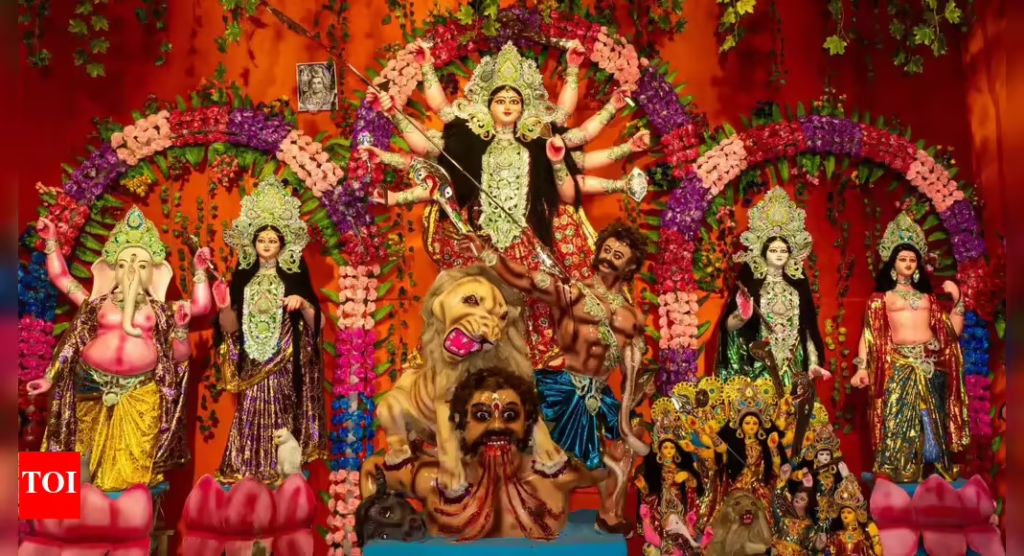Celebrate Durga Puja in India, also known as Durgotsav or Sharodotsav, is one of the most awaited festivals in India, especially in West Bengal, Odisha, Bihar, Assam, Jharkhand, and Tripura. This grand celebration honors Goddess Durga and her victory over the demon Mahishasura, symbolizing the triumph of good over evil. The festival usually lasts for five days—Shashthi, Saptami, Ashtami, Navami, and Dashami—but the preparations and excitement begin weeks in advance.
If you’re wondering how to celebrate Durga Puja in India, here’s a detailed guide that will take you through its traditions, rituals, food, cultural events, and modern-day celebrations.

1. Understanding the Significance of Durga Puja
Durga Puja is not just a religious festival—it is an emotion, a cultural extravaganza, and a time of community bonding. According to Hindu mythology, Goddess Durga descended on Earth to defeat Mahishasura, the buffalo demon, after he gained invincible powers. Her victory marks the celebration of feminine energy (Shakti), courage, and righteousness.
For Bengalis, Durga Puja is equivalent to Christmas or Diwali. It is more than worship—it is about art, culture, food, fashion, music, and social gatherings.
2. Preparing for the Festival
The preparations for Durga Puja start weeks before the actual festival. Here’s how:
- Cleaning and decorating homes: Families clean their houses, buy new curtains, lights, and decorative items.
- Shopping for new clothes: One of the biggest traditions is buying new clothes for every day of Puja. From traditional sarees and kurta-pajamas to modern outfits, everyone dresses their best.
- Pandal construction: Huge themed structures called pandals are built across cities and villages, each showcasing a different artistic design. Some resemble temples, palaces, or even famous landmarks from across the world.
- Idol making: Skilled artisans craft idols of Goddess Durga, her children (Lakshmi, Saraswati, Kartik, and Ganesha), and Mahishasura. These idols are beautifully painted and decorated with ornaments.
3. Rituals of Durga Puja
Each day of the Puja has its own importance and rituals:
- Shashthi: On this day, the goddess is welcomed with rituals like Kalaparambho (invoking the goddess) and Bodhon.
- Saptami: A banana plant (called Kola Bou) is dressed like a bride and placed near Lord Ganesha. This marks the symbolic presence of Goddess Durga.
- Ashtami: The most important day, celebrated with Anjali (offering flowers), Kumari Puja (worship of young girls as Durga’s embodiment), and the grand Sandhi Puja performed at the juncture of Ashtami and Navami.
- Navami: The final day of worship, marked by the Maha Aarti. Devotees seek blessings and prepare for the farewell of the goddess.
- Dashami (Vijaya Dashami): On the last day, women perform Sindoor Khela (smearing vermilion on each other), and the idols are immersed in rivers or lakes (Visarjan). It is both a moment of joy and sadness, as devotees bid farewell to the goddess with the chant: “Asche bochor abar hobe” (She will return next year).
4. The Cultural Side of Durga Puja
Durga Puja is not only about rituals; it’s a cultural carnival. Every pandal is a hub of creativity and community celebrations:
- Pandal hopping: Families and friends go from one pandal to another, admiring the unique themes, idols, and decorations. Some pandals even attract international tourists.
- Cultural programs: Dance, drama, plays, and musical concerts are organized, showcasing Bengali heritage. Rabindra Sangeet (songs of Rabindranath Tagore) and folk performances are quite popular.
- Art and exhibitions: Many pandals display local art, handlooms, and handicrafts. It becomes a platform for artists and artisans to showcase their work.
5. Food Delights During Durga Puja
No celebration in India is complete without food, and Durga Puja is no exception. Both vegetarian and non-vegetarian dishes hold importance during this time.
- Bhog: Devotees are served khichuri (a dish made with rice and lentils), labra (mixed vegetables), beguni (fried eggplant fritters), chutney, and sweets as prasad.
- Street food: Kolkata, in particular, becomes a food paradise with stalls selling rolls, chowmein, momos, phuchkas (pani puri), cutlets, kebabs, and Mughlai parathas.
- Sweets: Traditional Bengali sweets like rasgulla, sandesh, cham cham, and mishti doi are must-haves.
- Home feasts: Families prepare elaborate meals, including fish curries, mutton dishes, and festive desserts.
6. Fashion and Dressing Up
Durga Puja is also about looking your best:
- Women: Sarees, especially cotton, silk, and designer sarees, are the most popular choice. Younger women also wear salwar suits, lehengas, and Indo-western outfits.
- Men: Traditional attire like kurta-pajama or dhoti-kurta is common, though modern shirts and trousers are also worn.
- Children: Parents dress their kids in new, colorful outfits every day.
Fashion photography during pandal hopping is a trend, with many sharing their Puja looks on social media.
7. Community Bonding
Durga Puja is a festival of togetherness. Families reunite, relatives visit, and friends spend hours together pandal-hopping or enjoying meals. Even in housing complexes and societies, community pujas are organized where residents contribute and celebrate collectively.
The festival also brings together people of all religions and backgrounds. Non-Hindus equally participate, either as organizers, artists, or simply as admirers of the grandeur.
8. Durga Puja Beyond Bengal
Though Kolkata is the heart of Durga Puja, it is celebrated widely across India:
- Delhi: CR Park in Delhi is famous for its grand pandals and authentic Bengali food.
- Mumbai: Many Bollywood celebrities participate in Durga Puja, especially in community pandals organized by Bengali associations.
- Assam and Tripura: The celebrations are as grand as in Bengal, with traditional dances and feasts.
- International celebrations: Bengalis abroad in the US, UK, Canada, and Australia also organize Durga Pujas, keeping traditions alive.
9. The Modern-Day Touch
Today, Durga Puja has adopted many modern elements:
- Eco-friendly idols: To reduce water pollution, many artisans now create clay idols with natural colors.
- Digital celebrations: Live streaming of aarti and pujas help devotees across the world participate virtually.
- Social media buzz: Instagram, Facebook, and YouTube are flooded with Durga Puja reels, photos, and vlogs, making it a global phenomenon.
10. The Essence of Durga Puja
At its core, Durga Puja is about devotion, joy, and community spirit. It teaches us that no matter how powerful evil may seem, goodness will always triumph. It is also a reminder of the importance of culture, art, and human bonding in our lives.
When the final day comes, and the goddess is immersed, devotees feel emotional but hopeful. The promise of “Asche bochor abar hobe” keeps the excitement alive for the next year.
Conclusion
Durga Puja is not just a festival—it is a way of life. From the spiritual rituals to the artistic pandals, from the delicious food to the cultural events, every aspect of this celebration reflects the rich heritage of India.
If you ever wish to experience the real soul of Indian culture, plan a visit to Kolkata or any city in eastern India during Durga Puja. Walk through the pandals, enjoy the bhog, witness the sindoor khela, and immerse yourself in the music and joy of the season. You will realize why Durga Puja is considered one of the grandest festivals in the world.
